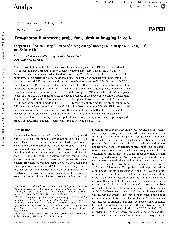摘要
A novel two-photon excited fluorescent probe for cadmium ( named as TPCd) was designed and synthesized utilizing a prodan (6-acetyl-2-methoxynaphthalene) derivative as the two-photon fluorophore and an o-phenylenediamine derivative as the Cd2+ chelator, which possessed favorable photophysical properties and good water-solubility. The probe was designed with a photoinduced electron transfer (PET) mechanism and thus was weakly fluorescent itself. After binding with Cd2+ which blocked the PET process, the fluorescence intensity of the probe was enhanced by up to 15-fold under one-photon excitation (OPE) and 27-fold under two-photon excitation (TPE), respectively. The two-photon action cross-section (Phi delta) of the TPCd-Cd complex at 740 nm reached 109 GM compared to 3.6 GM for free TPCd, indicating the promising prospect of the probe in two-photon application. TPCd chelated Cd2+ with 1 : 1 stoichiometry, and the apparent dissociation constant (K-d) was 6.1 x 10(-5) M for the one-photon mode and 7.2 x 10(-5) M for the two-photon mode. The probe responded to Cd2+ over a wide linear range from 0.1 to 30 mu M with a detection limit of 0.04 mu M. High selectivity of the probe towards Cd2+ was acquired in Tris-HCl/sodium phosphate buffer. The probe was pH-independent in the biologically relevant pH range and non-toxic to living cells at reasonable concentration levels, warranting its in vivo applications. Through two-photon microscopy imaging, the probe was successfully applied to detect Cd2+ uptake in living HepG2 cells.
